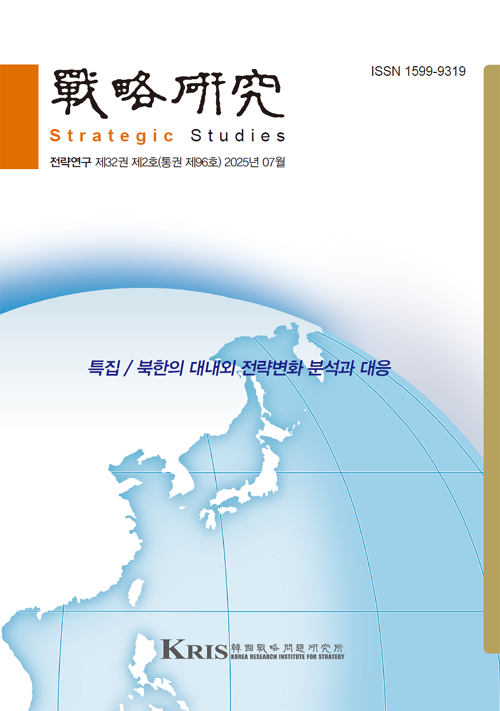전투발전 분야별 우선순위를 고려한 K-예비군 재설계 방향에 관한 연구: AHP 분석을 중심으로
A Study on the Redesigning direction of K-Reserve Forces Considering the Priority of Combat Development subjects: Focusing on AHP analysis
- 한국전략문제연구소
- 전략연구
- 제32권 제2호(통권 제96호)
-
2025.07213 - 255 (43 pages)
-
DOI : 10.46226/jss.2025.7.32..2.213
- 0

러시아-우크라이나 전쟁을 통해 예비전력에 대한 관심이 증가하고 병역자원 급감이 예상되는 미래 국방환경을 고려해 볼 때, 첨단과학 기술을 적용한 유무인 복합체계 등과 함께 예비전력도 미래 국방력을 유지하는 핵심 대안 중 하나일 것 이라는 예측이 적지 않다. 하지만, 안타깝게도 우리나라 예비군은 여전히 전투력 발휘에 대한 의구심을 받고 있다. 국방개혁과 국방혁신을 지속하면서 다양한 노력으로 예비전력 정예화를 추진해 왔지만, 예비군제도가 가지고 있는 법적, 구조적 한계와 방대한 규모로 인한 전력화 제한 등의 이유로 아직 만족할 만큼 혁신하지 못한 것이 사실이다. 본 연구의 목적은 독창성, 활용성, 효율성 등 K-의 우수한 특성을 가지고 있지만 여전히 상존하고 있는 전투력 발휘에 대한 의구심을 해소하고, 명실상부한 대한민국의 예비군으로 거듭나기 위한 재설계 방향을 제시하는데 있다. 이를 위해 합동 전투발전 분야(DOTMLPF-P)를 분석의 틀로 원용하여 현 예비군제도의 문제점을 도출, 예비군제도 재설계 모형을 구상하고, AHP 기법을 활용하여 각 전투발전 분야별 핵심요소의 우선순위를 분석하였다. 이후 분석된 우선순위를 고려하여 분야별 핵심요소의 재설계 방향을 제시하였다. 전투력 발휘가 가능한 우수한 대한민국 예비군 즉, K-예비군이라는 목표를 달성하기 위해서는 전투발전 분야별 우선순위와 각 분야 핵심요소의 복합 우선순위를 고려하여 정교하게 재설계 해나가야 하며, 이를 통해 예비전력이 연합전력, 상비전력과 함께 대한민국을 수호하는 굳건한 하나의 축으로 거듭날 수 있을 것이다.
Considering the future defense environment, marked by increased interest in reserve forces due to the Russia-Ukraine war and an anticipated sharp decline in military personnel resources, there are many predictions that reserve forces, alongside advanced science and technology-applied manned-unmanned teaming systems, will be a core alternative for maintaining future defense capabilities. Unfortunately, however, South Korea's reserve forces still face doubts regarding their combat readiness. While continuous defense reform and innovation efforts have aimed at professionalizing the reserve forces, it's true that they haven't achieved satisfactory innovation due to the legal and structural limitations of the reserve system and the constraints on full operational capability imposed by its vast scale. The purpose of this study is to propose a redesign direction for South Korea's reserve forces to dispel persistent doubts about their combat readiness, despite their excellent “K-” characteristics such as originality, usability, and efficiency, and to truly be reborn as a formidable component of the Republic of Korea's defense. To this end, the study adopted the Joint Combat Development subjects(DOTMLPF-P) as an analytical framework to identify problems within the current reserve system. Based on this, a redesign model for the reserve system was conceptualized, and the Analytic Hierarchy Process (AHP) was used to analyze the priorities of key elements within each combat development area. Subsequently, redesign directions for the key elements in each area were presented, considering the analyzed priorities. To achieve the goal of a highly capable South Korean reserve force-a “K-Reserve Force”-that can effectively conduct combat operations, a sophisticated redesign is necessary, taking into account the priorities of each combat development area and the composite priorities of the key elements within each area. Through this, the reserve forces can be reborn as a robust pillar, alongside combined forces and standing forces, in safeguarding the Republic of Korea.
Ⅰ. 서 론
Ⅱ. 이론적 배경 및 선행연구 분석
Ⅲ. 우리나라 예비군 제도의 전투발전 분야별 분석
Ⅳ. AHP 분석을 통한 K-예비군 재설계 우선순위
Ⅴ. 우선순위를 고려한 K-예비군 재설계 방향
Ⅵ. 결 론
참고문헌
(0)
(0)